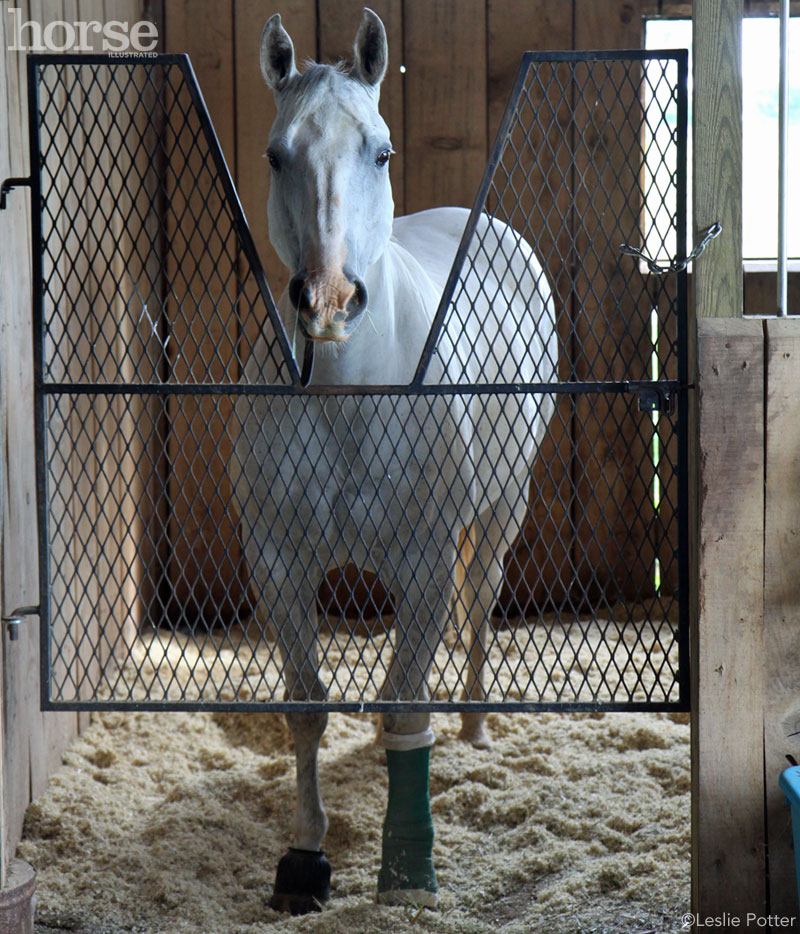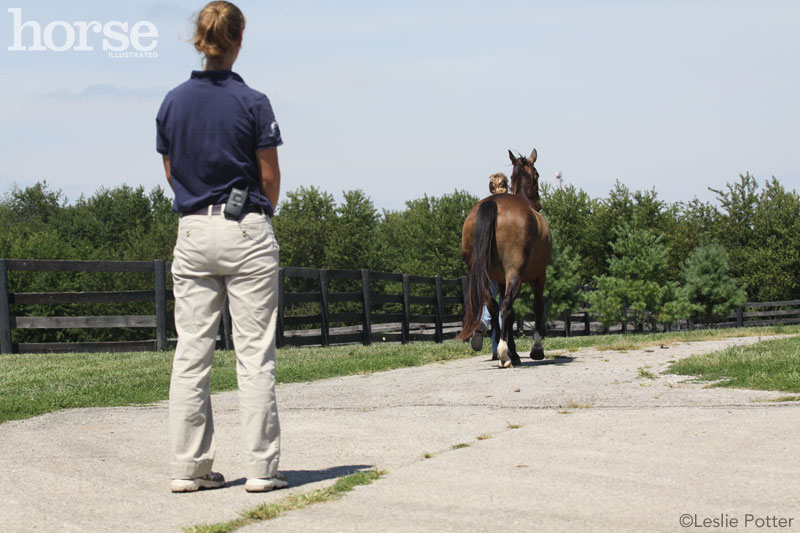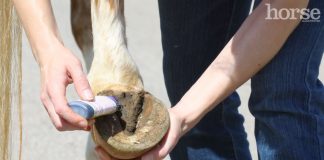
Every breed and riding discipline has its own set of tendon and ligament injuries, but across the board there are four major structures in the forelimbs that are most commonly injured. Here’s a look at those injuries and the prognosis for each, which in many cases is quite good thanks to veterinary advancements.
Anatomy and Physiology of Tendons and Ligaments
Tendons and ligaments are made from the same basic tissue and have the same basic structure. The tissue is a very strong fibrous material that groups together in bundles, forming long cords.
Tendons join muscle to bone and as a result, when the muscle contracts, the bone moves. Most tendons are designated as either flexor or extensor. Flexor tendons allow a joint to bend inward, toward the body (joint closes), and extensor tendons allow a joint to extend (joint opens).
Ligaments join bone to bone. They are stabilizing structures that essentially hold bones together and stop them from overextending, overflexing or overrotating.
There are four main tendons and ligaments at the back of the horse’s leg that do the majority of the work: suspensory ligament, inferior check ligament, deep digital flexor tendon and the superficial digital flexor tendon. In a horse’s forelegs, these four structures are the most commonly injured tendons and ligaments. When injury does occur in these structures, the infamous “bowing out” along the back of the leg is visible—in layman’s terms, the horse has a bow.
When Injuries Happen
Medically speaking, a bow can be different “types” of injuries involving tendons and ligaments: Strains that cause tendons and ligaments to stretch are described as type I lesions. They result in swelling of the tendon or ligament. Depending on the location and amount of swelling, the horse’s leg is usually only slightly enlarged, warm and painful, and lameness may or may not be present.
Fiber tearing is more serious and often results in increased swelling, more heat and often, but not always, lameness. Mild tearing is classified as a type II lesion. Severe tearing, classified as a type III lesion, causes increased signs of heat, swelling and pain; often, these horses are lame. The worst injury is massive tearing, classified as a type IV lesion; the damage causes severe lameness, with very obvious heat, pain and swelling.
In general, strains are better than tears, small tears are better than large ones, and damage that occurs away from bone is better than damage right at the bone.
The location of these injuries is classified into different zones along the back of the leg, but the general layman terms classify the injury into high, middle or low “bows,” corresponding with high, middle or low along the back of the cannon bone.
Most of these injuries occur in the forelimbs since they bear 60 percent of the horse’s weight and are therefore most prone to being overloaded. Of all the tendon and ligament injuries that can occur, the inferior check ligament is the least severe. The role of this ligament is to help stabilize the leg during weight bearing. Inferior check ligament injuries often cause a large swelling, but little pain or lameness.
The superficial digital flexor tendon is responsible for stability and flexion of the lower leg. When this tendon is injured, there is generally some lameness, but even severe damage may not be career ending.
The deep digital flexor tendon is a workhorse of a tendon: It not only stabilizes the leg during maximum load (full weight bearing), but also flexes all of the lower leg joints during hoof flight. If it’s significantly damaged, there is lameness, heat, pain and swelling, and it could be career ending.
Suspensory ligament in-juries are the most serious and can be the hardest to treat. Like the deep digital flexor tendon, an injury here causes lameness and swelling. The job of this ligament is to stabilize the leg during maximum load; it stops the fetlock from dropping to the ground.
With all of these structures, one thing is certain: The more severe the injury, the more lameness there is.

Depending on the tendon or ligament affected, and the type of injury that has occurred, a horse can have varying degrees of lameness, from mild to severe.
Signs of Trouble
Being familiar with what is normal in your horse’s legs, along with his normal way of going, will help you know when something isn’t right. The more severe or recent the injury, the more heat, pain and swelling that occur. Sometimes there is an enlargement in the area without lameness or obvious pain. When these enlargements occur though, it is still cause for concern. A veterinarian can palpate (feel) the leg and tell which tendon or ligament is involved, but a confirmed diagnosis comes from ultrasounding the affected area.
Ultrasound is the most basic and useful tool to evaluate these soft tissue injuries. From these images we can see which structure is damaged, the extent of damage, the location, and we can measure the damage. MRI is also used to diagnose soft tissue injury, as well as scintigraphy (scan).
The Healing Process
In the old days many horses were simply “turned out” for six months to heal a tendon/ligament injury and then rechecked. Certainly our minds have changed in this area over the last five years. If your horse is unlucky enough to get one of these injuries, today there are many options to help him recover.
The current thinking is to decrease inflammation and rest the horse to prevent any further damage. Icing and cold hosing are very effective for reducing inflammation within the first 48 to 72 hours after injury. The leg is wrapped for support and may be poulticed in an effort to decrease the inflammation further. I often use a gelcast, which is a special bandage that has magnesium salts in it that act like a poultice. It is combined with four other layers of wrapping and looks like a soft cast. It supports the fetlock and minimizes the pull on the back of tendons and ligaments, essentially resting the damaged area.
Anti-inflammatory drugs can be useful to keep pain and swelling down. If the injury is mild enough that it can be managed without these medications, sometimes the pain keeps the horse off the leg, which allows for rest and healing.
Depending on the severity of damage, the horse is usually stall rested for a length of time, then hand walked, and then put back to modified work until the area is healed. This process can be very subjective and variable depending on the horse, owner, environment and veterinarian. The current theory and practice is to start the horse back to modified work earlier in an effort to strengthen the tissues and help them realign as close as possible back to their original fiber pattern. However, under-saddle work is typically limited to a walk only within the first few months of injury.
Treatment Advances
Aside from rest, we now have many new treatments that are clinically proven to help tendons and ligaments heal stronger and get horses back to their performance lives. For some horses this means returning back to the level of previous workload, while others may need to step down to less demanding careers.
Extracorporeal shock wave therapy (ESWT) has become a very valid therapy for these types of injuries with a good deal of success. At this time it is unknown exactly how ESWT works, but it is thought that it increases blood flow, stimulates healing and possibly numbs pain.
Another treatment proven to be successful is bone marrow transplant. Bone marrow from the horse’s sternum is extracted and then transplanted into the area of damage. Here again, the full mechanism of how this works is unknown, but it is believed that within the bone marrow are chemical and cell mediators that stimulate healing, including stem cells.
This leads us into another area of exciting treatment options: stem cell therapy. It is now possible to extract stem cells from a horse’s own fat, and then use those cells for healing. Stem cells are those that haven’t differentiated into any specific type ofcell yet: They still have the potential to become skin, bone, tendon, ligament, et cetera. It’s an exciting concept because it means these cells can be placed in damaged tissue, allowing the tissue to then regenerate.
Another therapy is IRAP (interleukin-1 receptor antagonist protein). IRAP is a chemical mediator in the blood that stops the bad chemical mediators in the blood produced by inflammation from being able to do damage, and allows the good chemical mediators to work more effectively. Blood from the horse is taken and incubated on special glass beads which grow the IRAP. The IRAP is then harvested and injected into the injury site. Unfortunately, this therapy is not widely available yet, but that may change.
With the exception of stem cell therapy from fat, I have personally used all of these therapies on tendon and ligament injuries and have seen great success to the point of horses returning to their former level of competition or life. They are all exciting wonderful treatments that have opened the door for many horses and owners.
Our ability to diagnose, treat and prevent tendon/ligament injuries has improved tremendously over the last few years. Although these injuries are still extremely serious, they’re not as overwhelming as they once were. With good care and treatment, many tendon and ligament injuries can now be overcome.
Learn about updated diagnostic tools: Miracles of MRI.
Tendon and ligament injury Causes and Prevention.
Janice Posnikoff, DVM, heads up Orange County Equine Veterinary Services in Southern California.
This article originally appeared in the June 2006 issue of Horse Illustrated. Click here to subscribe.






i’m really glad to hear that these injuries can be cured! i know a horse that has an injury like this and hopefully he will get better
this ariticle is very good my horse has just got over felxor tendon this was very helpfull
very good article, it really helped me to understand
i love this article but would love to see another on what do do after the injury, such as what can help my horse restore flexion and can support the past injury while riding, i know to ice after work but what should be done when she isn’t working that can help
Very informative, my QH mare is getting over a severe tear of her Digital flexor and has undergone the Ultra sound shockwave therapy, i also have a light therapy pad for additional backup at home, I am very concerned about the return to work she has been out since July 6th 08, on stall rest, then in a 12×12 pen outside, she is now in a hot wire paddock, she looks awesome, but its a long process and very frustrating, make sure you have a great Equine vet as i do and plenty of $$$$
There is a old home remedy that I have used very succsessfull in Germany, to cool the Tendon apply a red clay paste 3x a day to the injury. It will natural cool and draw out Inflamation. Here it can be bought as Pascalite Bentonite Healing Powder. Another add thing you can do is a good supplement like Smart Tendon or Smart Repair, Supplements should have silica, MSM, Vitamin C,and Collagen in it, they promote the healing. I have found that leaving an old Horse in the Stall for too long will have more draw backs. I let my Horse out in the Pasture,he will not run since it hurts, but he is a lot less stiff.
this is a very informative article! a “diagram” of the mentioned tendons – ligaments would have been additionally helpful – please print any new updated information – as this article is dated 2006.
thanx!
This is a Ditto:
this is a very informative article! a “diagram” of the mentioned tendons – ligaments would have been additionally helpful – please print any new updated information – as this article is dated 2006.
thanx!
jal, Crawford, AL
This is one of the most informative article about tendon injuries, Thank you,
this is awesome information to know.. now i truly understand.. my horse just strained her suspensory ligament
today my vet told me my mare had a suspensory ligament strain … this article helped me understand the meaning a little better. thank you.
Where can I get Gel-Cast from?
good info
THx this is a good article! this helped me understand what happened to my 2 mares who have hurt a tendon in their right foreleg
My 9 year old gelding suffered torn left front superficial tendon & ligament May, 2010. Until Nov.2010, he showed no healing. He had stem cell treatment from Cave Creek Equine by Dr. Rich in Nov. and last ultra sound showed 90% healing of tendon and total healing of ligament. I share this as proof of stem cell miracle!!! My horse is now on a rehab program.
Thanks for the article, great information. Very clear and covered all the important stuff 🙂
Very and concise clarification of basic injuries , great reference for any horse carer. cheers Gary Battersby